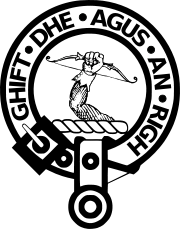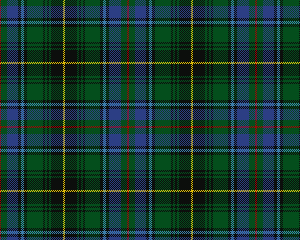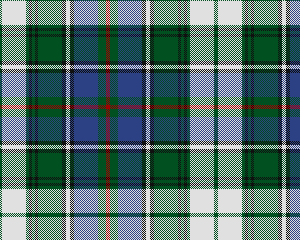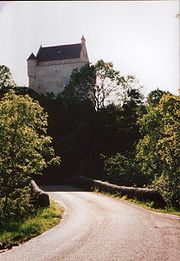
Clan MacInnes
Encyclopedia

Scottish clan
Scottish clans , give a sense of identity and shared descent to people in Scotland and to their relations throughout the world, with a formal structure of Clan Chiefs recognised by the court of the Lord Lyon, King of Arms which acts as an authority concerning matters of heraldry and Coat of Arms...
from the highlands
Scottish Highlands
The Highlands is an historic region of Scotland. The area is sometimes referred to as the "Scottish Highlands". It was culturally distinguishable from the Lowlands from the later Middle Ages into the modern period, when Lowland Scots replaced Scottish Gaelic throughout most of the Lowlands...
. As there is currently no clan chief, it is currently regarded as an Armigerous clan
Armigerous clan
An armigerous clan is a Scottish clan, family or name which is registered with the Court of the Lord Lyon and once had a chief who bore undifferenced arms, but does not have a chief currently recognized as such by Lyon Court...
.
Origins of the name


Scottish Gaelic language
Scottish Gaelic is a Celtic language native to Scotland. A member of the Goidelic branch of the Celtic languages, Scottish Gaelic, like Modern Irish and Manx, developed out of Middle Irish, and thus descends ultimately from Primitive Irish....
MacAonghais (Sons of Angus). Mac or Mc (as they are interchangeable) means son or family of, aon means one or unique, and gusa means choice. Therefore Unique Choice or Choice One. Mac does not imply strict bloodlines, but could reflect kinship, dependent allies or tenants. This name first appears in the seventh century Scottish Senchus fer n-Alban
Senchus fer n-Alban
The Senchus Fer n-Alban is an Old Irish medieval text, believed to have been compiled in the 10th century. It may have been derived from earlier documents of the 7th century which are presumed to have been written in Latin...
(The History of the Men of Scotland).
Arrival in Scotland
Clan MacInnes' ancestors were among the early inhabitants of IslayIslay
-Prehistory:The earliest settlers on Islay were nomadic hunter-gatherers who arrived during the Mesolithic period after the retreat of the Pleistocene ice caps. In 1993 a flint arrowhead was found in a field near Bridgend dating from 10,800 BC, the earliest evidence of a human presence found so far...
, Jura
Jura, Scotland
Jura is an island in the Inner Hebrides of Scotland, situated adjacent and to the north-east of Islay. Part of the island is designated as a National Scenic Area. Until the twentieth century Jura was dominated - and most of it was eventually owned - by the Campbell clan of Inveraray Castle on Loch...
and the Kintyre
Kintyre
Kintyre is a peninsula in western Scotland, in the southwest of Argyll and Bute. The region stretches approximately 30 miles , from the Mull of Kintyre in the south, to East Loch Tarbert in the north...
peninsula in Scotland
Scotland
Scotland is a country that is part of the United Kingdom. Occupying the northern third of the island of Great Britain, it shares a border with England to the south and is bounded by the North Sea to the east, the Atlantic Ocean to the north and west, and the North Channel and Irish Sea to the...
, generally part of the region known as Argyll
Argyll
Argyll , archaically Argyle , is a region of western Scotland corresponding with most of the part of ancient Dál Riata that was located on the island of Great Britain, and in a historical context can be used to mean the entire western coast between the Mull of Kintyre and Cape Wrath...
. These Scotti
Scoti
Scoti or Scotti was the generic name used by the Romans to describe those who sailed from Ireland to conduct raids on Roman Britain. It was thus synonymous with the modern term Gaels...
, a Celt
Celt
The Celts were a diverse group of tribal societies in Iron Age and Roman-era Europe who spoke Celtic languages.The earliest archaeological culture commonly accepted as Celtic, or rather Proto-Celtic, was the central European Hallstatt culture , named for the rich grave finds in Hallstatt, Austria....
ic, Gaelic
Goidelic languages
The Goidelic languages or Gaelic languages are one of the two branches of the Insular Celtic languages, the other consisting of the Brythonic languages. Goidelic languages historically formed a dialect continuum stretching from the south of Ireland through the Isle of Man to the north of Scotland...
-speaking people, first appear there as settlers from Ireland in c. 500 when Fergus Mór
Fergus Mór
Fergus Mór mac Eirc was a legendary king of Dál Riata. He was the son of Erc.While his historicity may be debatable, his posthumous importance as the founder of Scotland in the national myth of Medieval and Renaissance Scotland is not in doubt...
, king of the north Irish kingdom of Dál Riata
Dál Riata
Dál Riata was a Gaelic overkingdom on the western coast of Scotland with some territory on the northeast coast of Ireland...
, and his two brothers, Loarn and Óengus, expanded their lands into southwestern Alba
Alba
Alba is the Scottish Gaelic name for Scotland. It is cognate to Alba in Irish and Nalbin in Manx, the two other Goidelic Insular Celtic languages, as well as similar words in the Brythonic Insular Celtic languages of Cornish and Welsh also meaning Scotland.- Etymology :The term first appears in...
.
Óengus had already established a colony on Islay and/or Jura and was the master of ships for the new Kingdom. Óengus (Angus) is considered to be the first of the MacInnes Clan and is thought to be buried on Iona
Iona
Iona is a small island in the Inner Hebrides off the western coast of Scotland. It was a centre of Irish monasticism for four centuries and is today renowned for its tranquility and natural beauty. It is a popular tourist destination and a place for retreats...
. Dalriada quickly grew in influence and strength, and eventually overran the indigenous Pictish peoples and their culture. The area then became known as Scotland after these Scotti
Scoti
Scoti or Scotti was the generic name used by the Romans to describe those who sailed from Ireland to conduct raids on Roman Britain. It was thus synonymous with the modern term Gaels...
immigrants.
Expansion and decline
It is believed that MacInneses lived on Iona with ColumbaColumba
Saint Columba —also known as Colum Cille , Colm Cille , Calum Cille and Kolban or Kolbjørn —was a Gaelic Irish missionary monk who propagated Christianity among the Picts during the Early Medieval Period...
. Oengus and his descendants would have exploited their seagoing skills and ventured to Iona at an early time. Iona is the final resting-place of many MacInneses and lore says that Columba selected the site whereupon the Kiel Church now stands in Lochaline near Kinlochaline Castle
Kinlochaline Castle
Kinlochaline Castle is a 12th century Scottish fortress on the Ardtornish estate in Morvern in the Highland council area. It is also known as Caisteal an Ime because a Lady of Clan MacInnes, Dubh Chal , is said to have paid the builder with butter equal to the volume of the...
, the castle built by the MacInneses.
During the 9th century the clan moved out of the western isles and into Argyll (Morvern and Ardgour). This was most likely as a result of constant Viking
Viking
The term Viking is customarily used to refer to the Norse explorers, warriors, merchants, and pirates who raided, traded, explored and settled in wide areas of Europe, Asia and the North Atlantic islands from the late 8th to the mid-11th century.These Norsemen used their famed longships to...
raids in the islands.
By the early 12th century MacInnes people were well established in all of Morvern
Morvern
Morvern is a peninsula in south west Lochaber, on the west coast of Scotland. The name is derived from the Gaelic A' Mhorbhairne . The highest point is the summit of the Corbett Creach Bheinn which reaches in elevation....
(the peninsula bounded by Loch Sunart
Loch Sunart
Loch Sunart is a sea loch on the west coast of Scotland. Loch Sunart runs west from the sea, bounded to the north by the Sunart district of Ardnamurchan and to the south by the Morvern district. An inlet from Loch Sunart, Loch Teacuis, runs south-easterly into Morvern.At it is the longest sea...
and Loch Linnhe
Loch Linnhe
Loch Linnhe is a sea loch on the west coast of Scotland....
and adjacent to the Isle of Mull
Isle of Mull
The Isle of Mull or simply Mull is the second largest island of the Inner Hebrides, off the west coast of Scotland in the council area of Argyll and Bute....
). The traditional seat of the Chiefs of Clan MacInnes was established there in Kinlochaline Castle
Kinlochaline Castle
Kinlochaline Castle is a 12th century Scottish fortress on the Ardtornish estate in Morvern in the Highland council area. It is also known as Caisteal an Ime because a Lady of Clan MacInnes, Dubh Chal , is said to have paid the builder with butter equal to the volume of the...
. As the Viking raids continued to terrorize their lands the MacInneses became members of an alliance known as Siol Gillebride (Seed of the Servant of St. Bride) along with MacGillivrays, MacMasters and MacEacharns
Clan MacEacharn
Clan MacEacharn were a group of families who occupied lands in the Kintyre, Islay, and Morvern regions of Scotland. They are traditionally known as one of the oldest Western Highland family names...
somewhat in the manner of Clan Chattan
Chattan Confederation
Clan Chattan or the Chattan Confederation is a confederation of 16 Scottish clans who joined for mutual defence or blood bonds. Its leader was the chief of Clan Mackintosh.-Origins:The origin of the name Chattan is disputed...
, under the leadership of the Celtic-Norse warrior Somerled (killed in 1164, often referred to as Somerled MacGillebride, and his father was believed to be a MacAonghais Chief). Somerled’s grandson was the first of Clan Donald (McDougall and McDonald clans).
How the clan entered into this alliance is told as follows:
Chief of MacInnes sought Somerled to seek his aid. A skilled warrior, Somerled agreed to help them if they would follow his directions completely. He told them to kill and skin a herd of longhaired highland cattle, and to then march their normally kilt-clad fighters in plain sight of the invading Vikings. Next they were to dress in the cowhides with the long hair turned outwards and march again before their enemies; then a third time they were to march in front of the Vikings, but this time wearing the hides turned skin side out. The MacInnes men followed his advice. The Vikings were fooled into thinking the MacInneses had three times their actual fighting strength. They turned and fled the “overwhelming numbers” and many were slain. In thanks to Somerled, the MacInnes’ vowed to become his vassals.
In the mid 14th century, the last chief of Clan MacInnes was killed, along with his sons, by order of John of Islay, Lord of the Isles. Chief MacInnes had advised John to divorce his wife, Amy MacRuari, and marry the daughter of future king Robert II of Scotland
Robert II of Scotland
Robert II became King of Scots in 1371 as the first monarch of the House of Stewart. He was the son of Walter Stewart, hereditary High Steward of Scotland and of Marjorie Bruce, daughter of Robert I and of his first wife Isabella of Mar...
. Amy got revenge by telling John that MacInnes had complained that, while being lodged at John's residence, his quarters stank because they were used as a dog's kennel. Enraged, John ordered Donald, son of Lachlan MacLean, to kill MacInnes. These murders were carried out in Castle Ardtornish on the Sound of Mull
Sound of Mull
The Sound of Mull is a sound between the Inner Hebridean island of Mull and Scotland. It forms part of the Atlantic Ocean....
, and as a reward Clan MacLean were deeded the lands and castle of Ardgour. Clan MacInnes remains without a Chief, and many of the clan scattered to Appin
Appin
Appin is a remote coastal district of the Scottish West Highlands bounded west by Loch Linnhe, south by Loch Creran, east by the districts of Benderloch and Lorne, and north by Loch Leven...
, Craignish
Craignish
Craignish is a peninsula in Argyll, on the west coast of Scotland. It lies around south of Oban, and north of Lochgilphead. The peninsula is around long, and is aligned along a north-east to south-west orientation, in common with much of the landform of coastal Argyll. To the south is Loch...
, Lochaber
Lochaber
District of Lochaber 1975 to 1996Highland council area shown as one of the council areas of ScotlandLochaber is one of the 16 ward management areas of the Highland Council of Scotland and one of eight former local government districts of the two-tier Highland region...
and Skye, but some of the clan continued to occupy the castle.
Dispersal
In the 16th Century, many of the MacInnes Clan moved to SleatSleat
Sleat is a peninsula on the island of Skye in the Highland council area of Scotland, known as "the garden of Skye". It is the home of the clan MacDonald of Sleat...
on the Isle of Skye. Five longships are said to have made the journey, each holding a family group. From these five families are descended the five lineages of the name of MacInnes on the Isle of Skye. Some of these MacInnes men became the hereditary bowmen to the Mackinnon of Strath. The bowmen were known as Sliochd Neill a’ bhogha (The Line of Neil of the Bow). Others of the dispossessed Clan had joined with Clan Dugall Craignish
Campbell of Craignish
The Campbells of Craignish , form one of the oldest branches of the ancient and powerful Clan Campbell in Scotland.. They claim descent from Dugald Campbell, the second son of Sir Archibald Gillespic Campbell , 5th Knight of Lochawe and 20th Chief of Clan Campbell at the time...
and some went to Perthshire and joined with the MacGregors, leading to an ill-informed present-day claim that MacInnes is a Sept of MacGregor. It should be also noted that Clan Innes
Clan Innes
Clan Innes is a Scottish clan. The clan is without a chief that is recognised by the Lord Lyon King of Arms therefore it can be considered an armigerous clan. The clan takes its name from the lands of Innes in Moray, Scotland....
is unrelated to MacInnes having arisen in Moray east of Inverness at a later date.
Jacobite Uprisings
During the Jacobite uprisings most of the Clan MacInnes supported the British government however one branch of the clan fought for the Jacobite cause:In the 1745 Jacobite Rising
Jacobite rising
The Jacobite Risings were a series of uprisings, rebellions, and wars in Great Britain and Ireland occurring between 1688 and 1746. The uprisings were aimed at returning James VII of Scotland and II of England, and later his descendants of the House of Stuart, to the throne after he was deposed by...
, MacInnes Clansmen took up arms on both sides. Some stood with the Campbells and the House of Argyll
Duke of Argyll
Duke of Argyll is a title, created in the Peerage of Scotland in 1701 and in the Peerage of the United Kingdom in 1892. The Earls, Marquesses, and Dukes of Argyll were for several centuries among the most powerful, if not the most powerful, noble family in Scotland...
, but others (MacInneses of Morvern, Lochaber and Appin) supported Prince Charles Edward Stuart
Charles Edward Stuart
Prince Charles Edward Louis John Casimir Sylvester Severino Maria Stuart commonly known as Bonnie Prince Charlie or The Young Pretender was the second Jacobite pretender to the thrones of Great Britain , and Ireland...
and fought beside Stewart of Ardshiel, who commanded of the Appin (Stewart) Regiment. A MacInness clansman, MacMaster of Glenaladale, raised Prince Charles banner at Glenfinnan
Glenfinnan
Glenfinnan is a village in Lochaber area of the Highlands of Scotland. It is located at the northern end of Loch Shiel, at the foot of Glenfinnan.- Glenfinnan Monument :...
. Four MacInnes men were killed and two wounded in the battle. Others may have been captured and subsequently hanged. Donald Livingstone
Clan MacLea
The Clan MacLea is a Highland Scottish clan, which was traditionally located in the district of Lorn in Argyll, Scotland, and is seated on the Isle of Lismore. There is a tradition of some MacLeas Anglicising their names to Livingstone, thus the also refers to clan as the Highland Livingstones...
, the 18-year-old son of Anna MacInnes of Morvern, saved the Appin Banner from Culloden and smuggled it home. The banner is now housed in the Museum of Scotland. These kinsmen are buried in the cemetery of Kiel Kirk (Kiel Church) in Lochaline
Lochaline
Lochaline is the main village in Morvern. It is situated at the mouth of Loch Aline, on the northern shore. Lochaline is connected with Fishnish on the Isle of Mull by ferry....
Morvern. The church and cemetery exist today, with many old grave stones housed in the session house next to the church. One John McGinnes helped row Charles to safety and when captured and flogged, refused to disclose the details.
The Highland Clearances
The Highland ClearancesHighland Clearances
The Highland Clearances were forced displacements of the population of the Scottish Highlands during the 18th and 19th centuries. They led to mass emigration to the sea coast, the Scottish Lowlands, and the North American colonies...
, from about 1790 to 1840s, drove many MacInneses from their homes, notably on Skye and Mull. These Clearances were designed to get the tenant farmers off the land to make room for profitable sheep herding. Poverty, crop failures and high rents also contributed to the tide of emigration that emptied the highlands during the 19th Century. Numerous parish cemeteries on Mull, Skye, Iona, Islay and across Argyll hold the remains of clansmen.
Clan Castle

Kinlochaline Castle
Kinlochaline Castle is a 12th century Scottish fortress on the Ardtornish estate in Morvern in the Highland council area. It is also known as Caisteal an Ime because a Lady of Clan MacInnes, Dubh Chal , is said to have paid the builder with butter equal to the volume of the...
was the seat of the chief of Clan MacInnes for much of the Clan's history. In 1645, during the English Civil War
English Civil War
The English Civil War was a series of armed conflicts and political machinations between Parliamentarians and Royalists...
, the castle was attacked and burned by MacDonalds
Clan Donald
Clan Donald is one of the largest Scottish clans. There are numerous branches to the clan. Several of these have chiefs recognised by the Lord Lyon King of Arms; these are: Clan Macdonald of Sleat, Clan Macdonald of Clanranald, Clan MacDonell of Glengarry, Clan MacDonald of Keppoch, and Clan...
serving under James Graham, 1st Marquess of Montrose
James Graham, 1st Marquess of Montrose
James Graham, 1st Marquess of Montrose was a Scottish nobleman and soldier, who initially joined the Covenanters in the Wars of the Three Kingdoms, but subsequently supported King Charles I as the English Civil War developed...
, a member of Clan Graham
Clan Graham
Clan Graham is a Scottish clan who had territories in both the Scottish Highlands and Lowlands.-Origins:Legend has it that the first Graham was one Gramus who forced a breach in the Roman Antonine wall known as Graeme's Dyke in 420 A.D...
. Clan MacInnes retained control of the castle following this attack, along with a later attack in 1679 during a feud with the Archibald Campbell, 9th Earl of Argyll
Archibald Campbell, 9th Earl of Argyll
Archibald Campbell, 9th Earl of Argyll was a Scottish peer.He was born in 1629 in Dalkeith, Scotland, the son of Archibald Campbell, 1st Marquess of Argyll....
. The castle, which was then heavily damaged, was abandoned by Clan MacInnes around 1690.
Crest
The oldest crest of the MacInneses is a bee on a thistle and the motto “E labore Dulcedo” (English: In labor, pleasure) coming from an incident in the 13th century when a MacInnes Chief was awakened by a bee sting to lead his forces in surprising and defeating a party of Viking raiders.The above crest appears to be an historical inaccuaracy. See the MacInnes Clan page for an explanation of how it occurred:
http://macinnes.org/crests/WhatHappenedTB.html
In 1960, a branch of the Clan matriculated arms from which was adopted the crest of a Right Arm in Proper Tartan Holding a Bow and the motto “Irid Ghipt Dhe Agus an Righ” (English: By the grace of God and King). This crest was adopted for commercial use by the Council of Chiefs. Since there is no Clan Chief, the arms are lodged with Lord Lyon King of Arms
Lord Lyon King of Arms
The Lord Lyon King of Arms, the head of Lyon Court, is the most junior of the Great Officers of State in Scotland and is the Scottish official with responsibility for regulating heraldry in that country, issuing new grants of arms, and serving as the judge of the Court of the Lord Lyon, the oldest...
.
That branch of the MacInnises emigrated from Skye and founded a farm in Nova Scotia in the 19th century called Malagawatch. As such the "arm & bow" crest and the motto above are part of the Arms of MacInnes of Malagawatch.
In 2004, the International Association of Clan MacInnes was granted Arms by the Court of Lord Lyon which incorporated the "arm & bow", with slight modifications, atop a wholly new coat of arms incorporating significant symbols related to the history of the Clan.
Septs
The following are the septsSept (social)
A sept is an English word for a division of a family, especially a division of a clan. The word might have its origin from Latin saeptum "enclosure, fold", or it can be an alteration of sect.The term is found in both Ireland and Scotland...
of Clan MacInnes along with the spelling variations of each; Angus, Canch, Cansh, Caunce, Hance, MacAngus, MacAinish, MacAinsh, MacAneiss, MacAninch, MacAninsh, MacAnsh, MacAonghais, MacAonghuis, MacCainsh, MacCance
Related names
There are many Anglicized spellings of the name: MacInnis, Macinnis, McInnis, Macinnes, McInnes, McGinnis (not to be confused with McGuinnes), McKinnis, MacAngus, McAninch, McIninch, McKynes, M'Aneiss, McCanse, McNiesh, McAinsh and many more, since Mac and Mc are interchangeable.Masters, MacMaster and variants are of the Clan. To this day there are 157 variants of the spelling of the name 'MacInnes' including spellings with Mc, Mac, and the occasional G.
The name “Innes” is often linked to MacInnes. Innes originally has a later origin in Moray, but a number of people with the surname "MacInnes" dropped the "Mac", in common with holders of other Mac- names, during times when it was unfavourable to be identified as a Gaelic speaker.
External links
- http://www.electricscotland.com/webclans/m/macinne.html
- http://www.macinnes.org/

